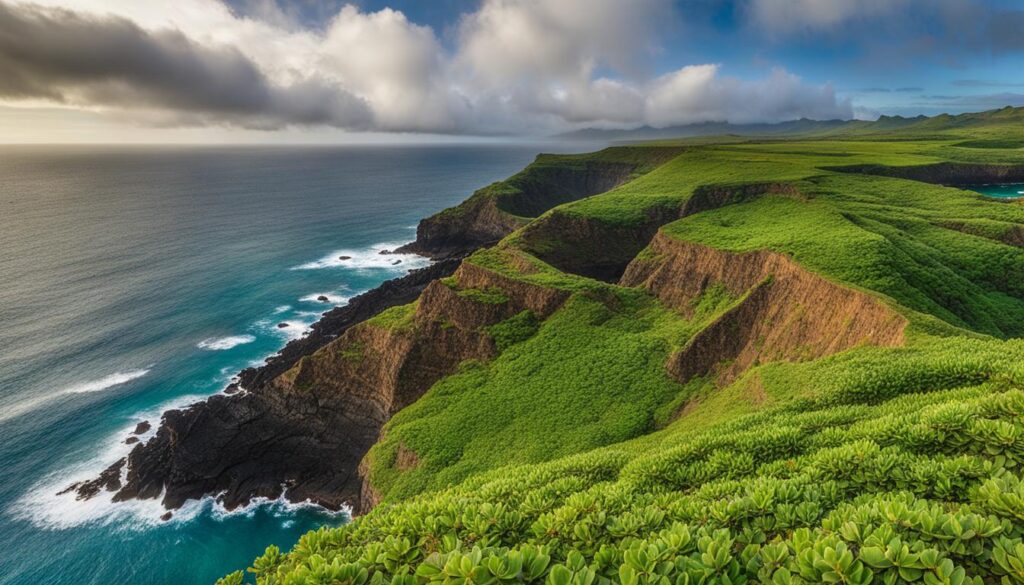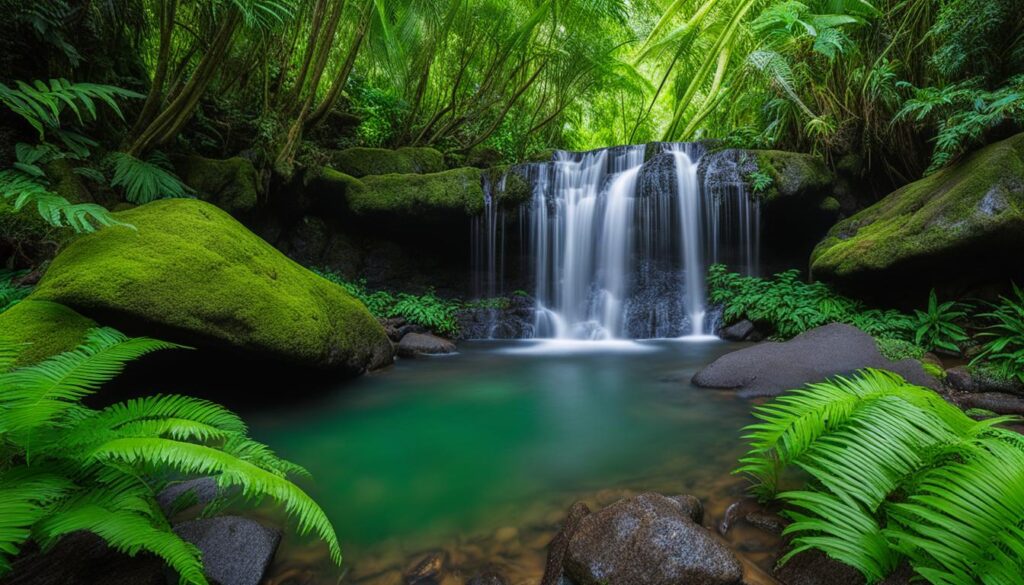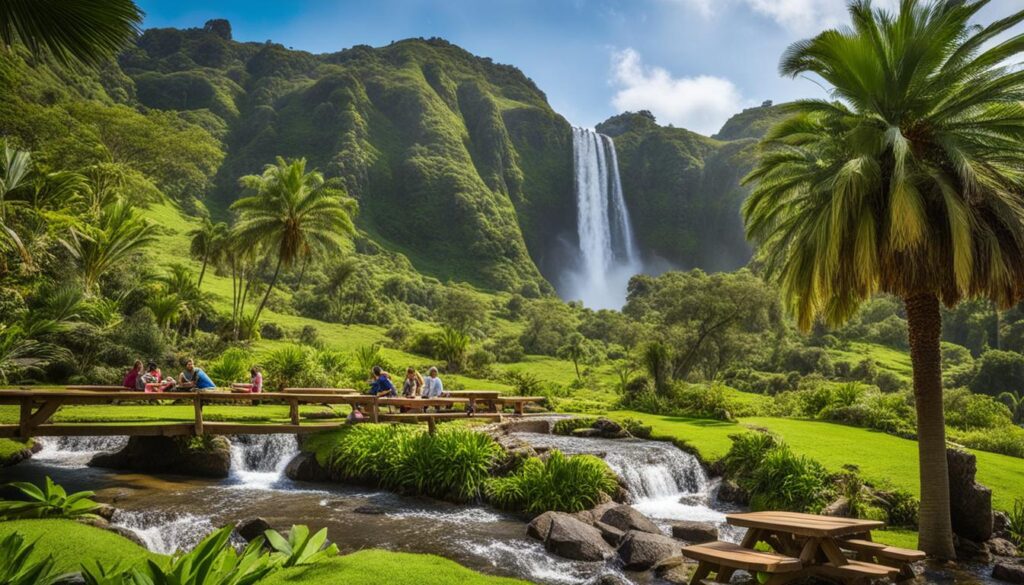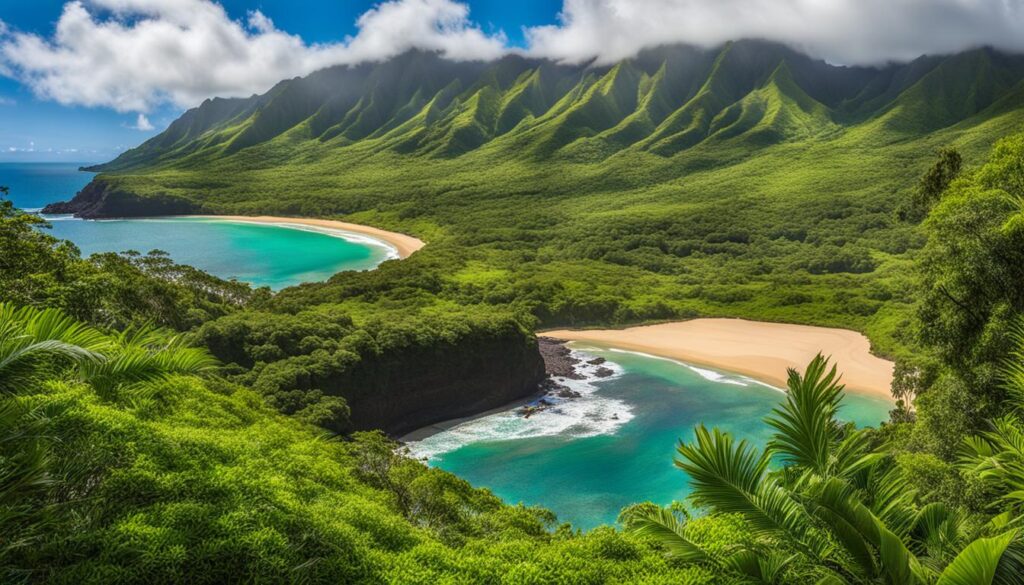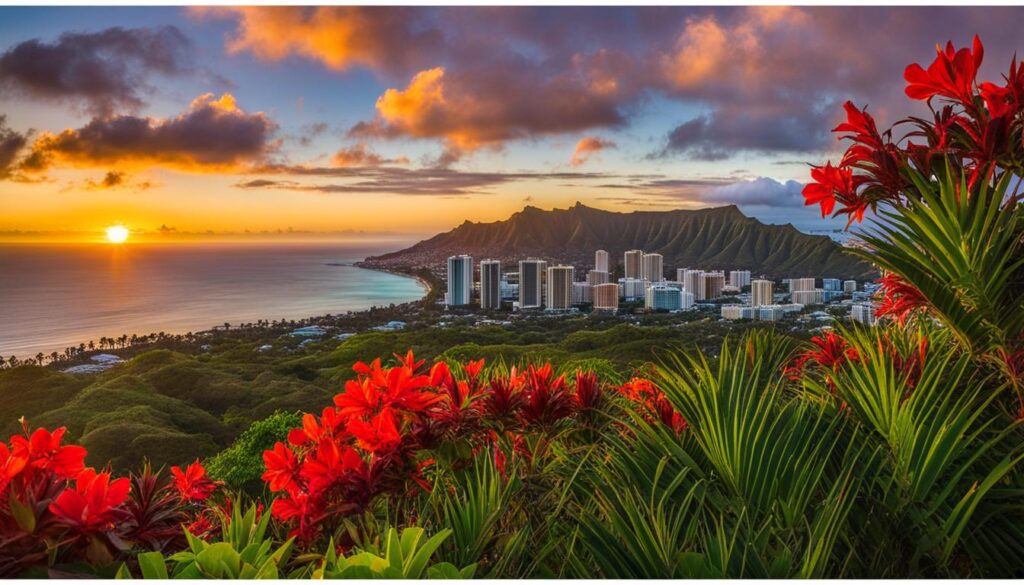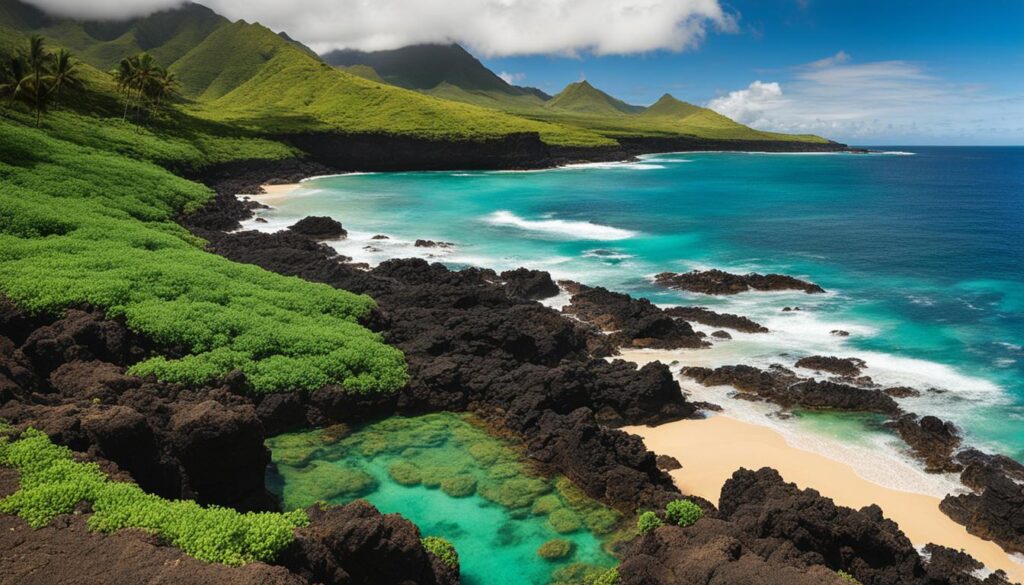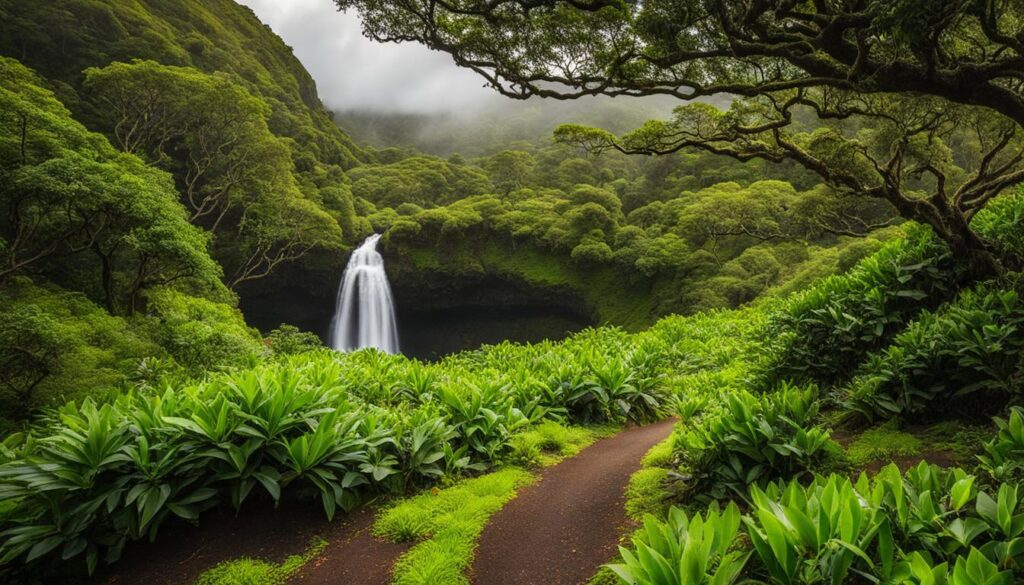Welcome to Kaena Point State Park, a hidden gem on the breathtaking coastline of Hawaii. This remote and wild park offers untouched beauty, native wildlife, and tranquil walking trails, making it a paradise for nature enthusiasts and adventure seekers alike. Whether you’re an avid hiker or simply looking to unwind in nature’s embrace, Kaena Point State Park has something for everyone.
Key Takeaways:
- Discover the untouched beauty of Kaena Point State Park in Hawaii
- Immerse yourself in the native wildlife and tranquil walking trails
- Explore the remote and wild coastline for a unique and unforgettable experience
- Don’t forget to pack water and sun protection for the hot and dry climate
- Plan your visit to Kaena Point State Park and uncover the hidden wonders of Hawaii
Contents
- 1 Essential Information about Kaena Point State Park
- 2 Park Highlights at Kaena Point State Park
- 3 Outdoor Recreational Activities at Kaena Point State Park
- 4 Wildlife and Conservation at Kaena Point State Park
- 5 Scenic Views and Cultural Significance at Kaena Point State Park
- 6 Services and Facilities at Kaena Point State Park
- 7 Park History of Kaena Point State Park
- 8 Planning Your Visit to Kaena Point State Park
- 9 Nearby Parks and Trails
- 10 Conclusion
- 11 FAQ
- 12 Source Links
Essential Information about Kaena Point State Park
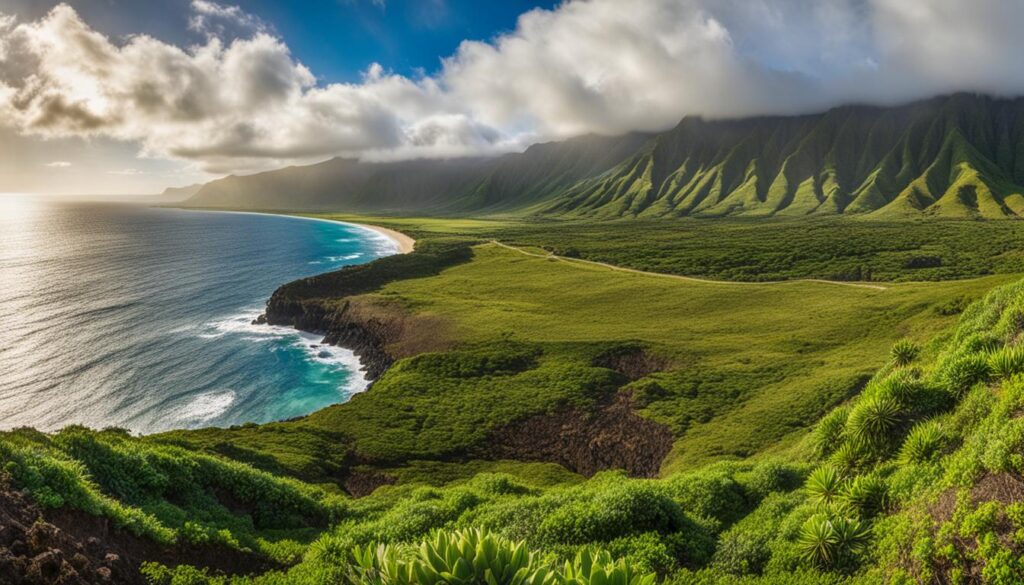
If you are planning a visit to Kaena Point State Park, it is important to know some essential information to make the most of your experience. Here are a few things you should keep in mind:
Opening Hours
Kaena Point State Park is open daily from 6:00 AM to 7:00 PM. During these hours, you can explore the park’s trails, enjoy the scenic views, and immerse yourself in nature. It is advisable to plan your visit accordingly to ensure you have enough time to explore the park’s beauty.
Vehicle Access and Permits
The Mokule’ia Section of the park is currently closed for vehicle access due to saturated roads. However, the Keawa’ula Section is accessible by vehicle. Keep in mind that permitted gate vehicle access requires a special use permit. To obtain a permit, you will need to apply through the park’s website. Please note that permits and login are required for permitted gate vehicle access.
Trail Sections and Climate
Kaena Point State Park offers two trail sections: the Kaena Point Mokule’ia Section and the Kaena Point Keawa’ula Section. Both sections provide stunning views and chances to encounter native wildlife. However, it is important to be prepared for the park’s hot and dry climate with little shade. Make sure to bring water, sunscreen, and suitable clothing to protect yourself from the sun.
| Information | Details |
|---|---|
| Opening Hours | 6:00 AM to 7:00 PM daily |
| Vehicle Access | Permitted gate vehicle access requires a special use permit |
| Trail Sections | Kaena Point Mokule’ia Section and Kaena Point Keawa’ula Section |
| Climate | Hot and dry with little shade |
Park Highlights at Kaena Point State Park
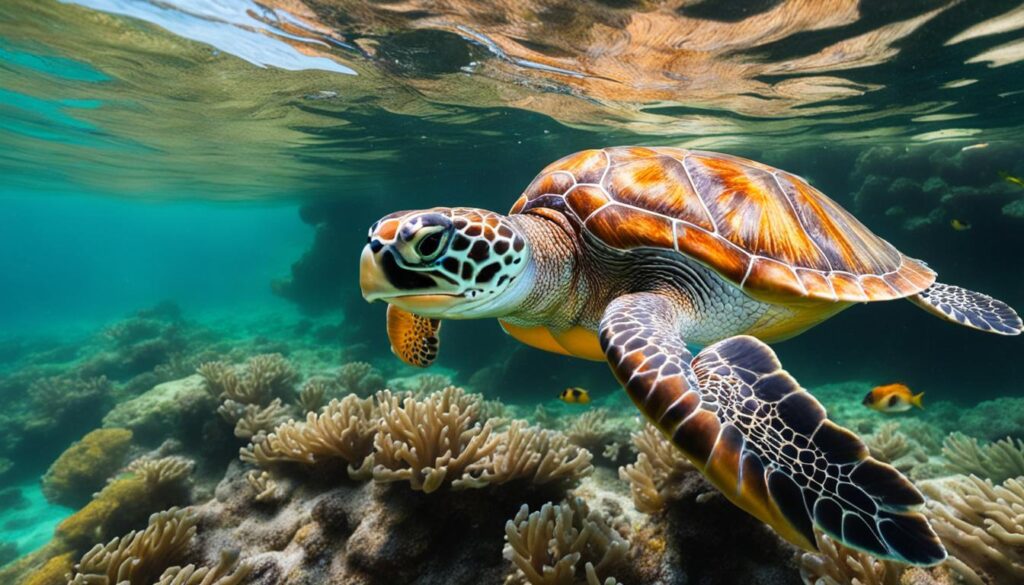
When visiting Kaena Point State Park, there are several highlights that you won’t want to miss. From stunning beaches to unique geological features, the park offers something for everyone to enjoy.
Keawa’ula Section
The Keawa’ula Section of the park is known for its picturesque sandy beach at Keawa’ula Bay. This beach is perfect for board surfing, body surfing (for experts only), and swimming during calm conditions. Whether you’re looking to catch some waves or simply relax on the shore, this beach is a must-visit spot in the park.
Mokule’ia Section
The Mokule’ia Section of Kaena Point State Park offers a different set of highlights. Here, you’ll find sandy and rocky coves, tide pools, sand dunes, and even endangered invertebrate habitats. Take a stroll along the coastline and explore the natural wonders that this section has to offer. Don’t forget to keep an eye out for the large sea cave known as Kaneana, as well as the stunning sand dunes and sea arch.
Native Wildlife
In addition to its beautiful landscapes, Kaena Point State Park is home to a diverse array of native wildlife. As you explore the park, you may spot marine mammals, seabirds, and native invertebrates. Bird watching is a popular activity, with numerous seabirds frequenting the shoreline. The park also plays a significant role in wildlife conservation, with regulations in place to protect spinner dolphins and Hawaiian Monk Seals. It’s a great place to appreciate and learn about Hawaii’s unique ecosystem.
Geological Features
The park is also known for its intriguing geological features. From the sandy beaches and sand dunes to the sea arch and sea cave, there is much to explore and admire. These geological formations provide a glimpse into the natural history of the area and offer stunning backdrops for your outdoor adventures. Don’t forget your camera to capture the beauty of Kaena Point State Park.
With its beautiful beaches, fascinating geological features, and abundant wildlife, Kaena Point State Park has much to offer visitors. Whether you’re a beach lover, a nature enthusiast, or simply looking to escape the hustle and bustle of everyday life, this park is a hidden gem in Hawaii. Plan your visit and immerse yourself in the park’s breathtaking highlights.
Outdoor Recreational Activities at Kaena Point State Park
If you’re looking for outdoor adventure and exploration, Kaena Point State Park has plenty to offer. From hiking trails that showcase the park’s natural beauty to bird watching opportunities that allow you to observe native wildlife, there’s something for everyone.
Hiking Trails
One of the main outdoor recreational activities at Kaena Point State Park is hiking. The trail to Kaena Point is 2.7 miles one-way and provides stunning views of the volcanic coast, majestic mountains, and the vast expanse of the ocean. As you make your way along the trail, you’ll be immersed in the untouched beauty of the park. It’s important to note that the trail can be challenging in some sections, so make sure to wear appropriate footwear and carry plenty of water.
Bird Watching
Kaena Point State Park is a haven for bird watchers. The park’s coastline is home to numerous seabirds, providing a unique opportunity to observe these remarkable creatures in their natural habitat. From albatrosses soaring in the sky to elegant shorebirds feeding along the shoreline, bird watching enthusiasts will be delighted by the diverse avian species that call Kaena Point home.
In addition to hiking and bird watching, visitors can also enjoy picnicking and shoreline fishing at Kaena Point State Park. Whether you’re seeking an adrenaline-fueled adventure or a peaceful retreat into nature, this park offers the ideal outdoor experience.
| Outdoor Recreational Activities | Features |
|---|---|
| Hiking Trails | 2.7-mile trail with scenic views of the coast, mountains, and ocean |
| Bird Watching | Opportunity to observe a variety of seabird species |
| Picnicking | Enjoy a leisurely meal surrounded by nature |
| Shoreline Fishing | Try your hand at fishing along the park’s shoreline |
Wildlife and Conservation at Kaena Point State Park
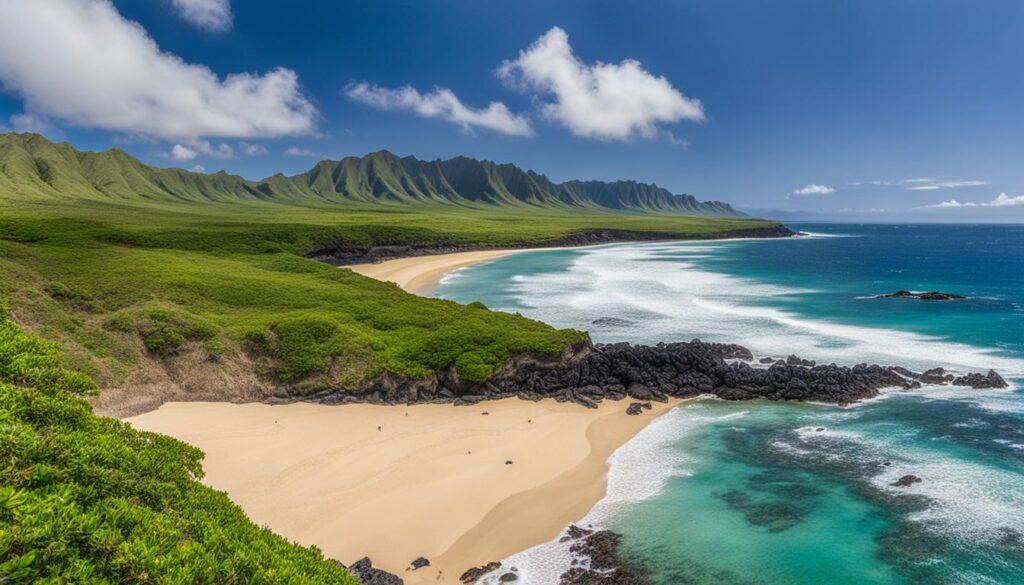
Kaena Point State Park is not only a haven for outdoor enthusiasts but also a vital sanctuary for native wildlife. The park’s commitment to wildlife conservation has led to the preservation and restoration of its diverse ecosystem, ensuring the protection of endangered species and the proliferation of native plant species.
The park is home to a wide variety of marine mammals, including spinner dolphins and Hawaiian Monk Seals. To safeguard these cherished creatures, regulations are in place to minimize disturbance to their natural habitats and protect their breeding grounds. Visitors are encouraged to observe these remarkable animals from a safe distance, allowing them to thrive undisturbed.
“The conservation efforts at Kaena Point State Park play a crucial role in preserving the natural beauty and biodiversity of this unique coastal ecosystem. It serves as a testament to the importance of protecting our natural heritage for future generations.”
The Importance of Native Plant Species
In addition to its wildlife conservation efforts, the park places a strong emphasis on the preservation of native plant species. The unique climate and geography of Kaena Point provide a suitable habitat for many endemic plants, some of which are rare and threatened. By actively restoring and maintaining these plant populations, the park contributes to the overall health and resilience of the ecosystem.
| Endangered Species Protection | Native Plant Species |
|---|---|
| Protection of spinner dolphins and Hawaiian Monk Seals | Preservation and restoration of native plant populations |
| Regulations to minimize disturbance to breeding grounds | Enhancement of overall ecosystem health and resilience |
| Conservation efforts to safeguard vulnerable species | Contributions to the preservation of Hawaii’s native flora |
By promoting wildlife conservation and preserving native plant species, Kaena Point State Park serves as a model for sustainable management and stewardship. It is a testament to the importance of protecting and preserving the fragile ecosystems that make Hawaii such a unique and remarkable destination.
Additional Resources:
- Learn more about the endangered species protection efforts in Hawaii: https://hdoa.hawaii.gov/pi/files/2013/01/EWT_Booklet.pdf
- Discover Hawaii’s native plant species: https://dlnr.hawaii.gov/hisc/info/native-plants/
Scenic Views and Cultural Significance at Kaena Point State Park
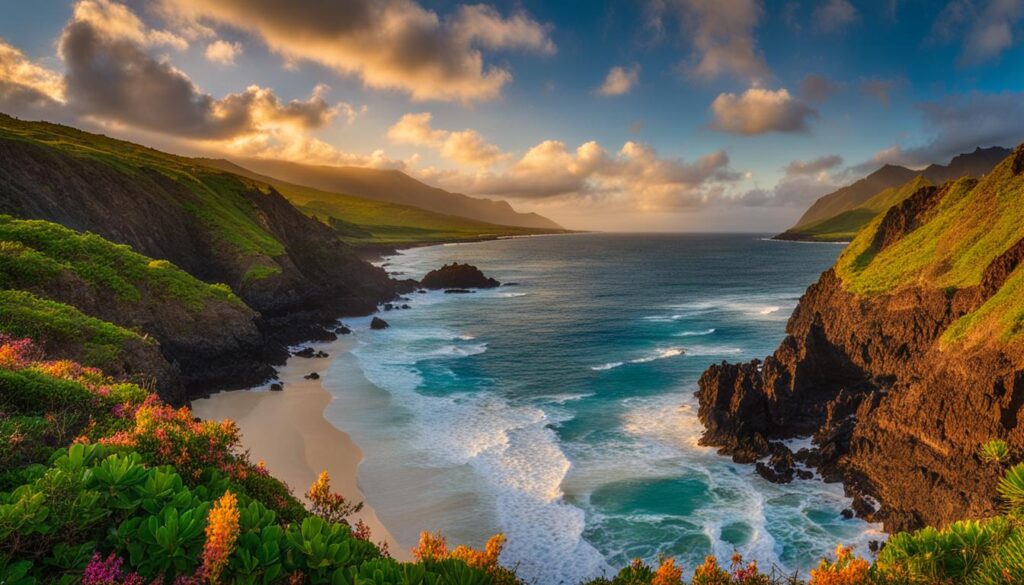
Kaena Point State Park offers visitors breathtaking scenic views that showcase the untouched beauty of the volcanic coast, ocean, and mountains. Whether you’re standing atop the sand dunes, gazing out at the vast expanse of the Pacific, or exploring the rocky coves and tide pools, the park provides a truly awe-inspiring experience. The diverse landscape and dramatic geological features make it a paradise for nature enthusiasts and photographers.
But Kaena Point State Park is not only renowned for its natural splendor. It also holds immense cultural significance for the Hawaiian people. This area has deep roots in Hawaiian history and folklore, as it is believed to be the “jumping-off” point for souls leaving this world and entering the afterlife. The park is named after the volcano goddess, Pele, who is an important figure in Hawaiian mythology.
As you explore the park, you’ll come across ruins of old stone walls and platforms, serving as reminders of the ancient Hawaiian settlements that once thrived here. These archaeological remnants provide a glimpse into the rich cultural heritage of the area and the lives of the people who lived here centuries ago. It’s a unique opportunity to connect with the history and traditions of the Hawaiian people.
Overall, Kaena Point State Park offers a remarkable blend of scenic beauty and cultural significance. Whether you’re captivated by the stunning views or intrigued by the stories of the past, a visit to this park is sure to leave a lasting impression.
Table: Cultural Significance at Kaena Point State Park
| Aspect | Description |
|---|---|
| Hawaiian Mythology | The park is named after the volcano goddess, Pele, and is believed to be the “jumping-off” point for souls leaving this world. |
| Archaeological Remnants | Ruins of old stone walls and platforms can be found throughout the park, providing insights into ancient Hawaiian settlements. |
| Connection to Hawaiian History | Through its cultural significance, the park offers visitors the opportunity to connect with the rich history and traditions of the Hawaiian people. |
Services and Facilities at Kaena Point State Park
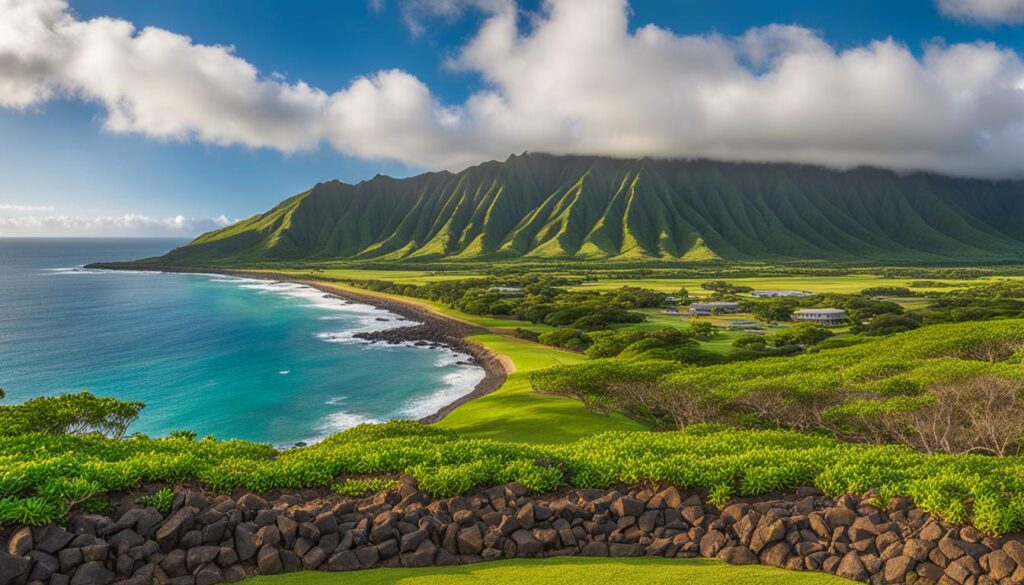
When visiting Kaena Point State Park, visitors can expect to find a range of services and facilities to enhance their experience. While the Keawa’ula Section offers lifeguard services, a comfort station, and a sandy beach for recreational activities, the Mokule’ia Section has some limitations. It does not have lifeguards or a comfort station, and there are no restrooms available in this section.
In the Keawa’ula Section, lifeguard services ensure the safety of beachgoers, providing peace of mind while enjoying the beautiful sandy beach at Keawa’ula Bay. The comfort station offers convenient restroom facilities, allowing visitors to freshen up during their outing. The sandy beach is perfect for various recreational activities such as swimming during calm conditions, board surfing, and body surfing (experts only).
On the other hand, the Mokule’ia Section does not have restrooms or lifeguards. Therefore, visitors should plan accordingly and make use of the restrooms before entering this section of the park. It is important to be aware of this limitation and consider bringing necessary supplies such as hand sanitizer or wet wipes for personal hygiene.
Overall, while the Keawa’ula Section provides services and facilities to ensure a comfortable and safe visit, visitors exploring the Mokule’ia Section should be prepared for the lack of restrooms and lifeguards. It is also essential to remember that there is no drinking water available in either section, so visitors should bring their own supply of water to stay hydrated throughout their visit.
| Facilities | Keawa’ula Section | Mokule’ia Section |
|---|---|---|
| Lifeguard Services | Available | Not Available |
| Restrooms | Available | Not Available |
| Comfort Station | Available | Not Available |
| Drinking Water | Not Available | Not Available |
Park History of Kaena Point State Park
Kaena Point State Park has a fascinating history that dates back to ancient Hawaii. This remote and wild coastline park was once a significant fishing and farming hub for the ancient Hawaiians, providing them with bountiful resources from the land and sea. The area was believed to be a sacred place where souls would depart from this world, making it a spiritual “jumping-off” point.
During the sugarcane era, Kaena Point became a railroad site, further adding to its historical significance. The remnants of this industrial past can still be seen throughout the park, reminding visitors of its transformation over time. Archaeological evidence suggests that the park was also home to ancient Hawaiian settlements, with ruins of old stone walls and platforms scattered throughout the area.
Today, Kaena Point State Park not only preserves its natural splendor but also its cultural significance. The park’s name pays homage to the volcano goddess Pele, and its rich history is a testament to the enduring connection between the land, the people, and their traditions. Exploring the park allows visitors to not only appreciate its untouched beauty but also learn about the ancient Hawaiians who once thrived in this remarkable coastal landscape.
| Key Points | Ancient Hawaiians | Fishing and Farming Hub | Railroad Site | Cultural Significance |
|---|---|---|---|---|
| Historical Importance | Central to the lives of ancient Hawaiians, who relied on the abundant resources provided by the land and sea. | Kaena Point served as a vital hub for fishing and farming activities, sustaining the local communities. | The park’s history includes its role as a railroad site during the sugarcane era, reflecting the changing times and industries. | Named after the volcano goddess Pele and believed to be a spiritual “jumping-off” point for departing souls. |
| Archaeological Evidence | Remnants of ancient Hawaiian settlements, including stone walls and platforms, offer insight into the past. | – | – | – |
| Preservation | – | – | The park preserves the remnants of its industrial past, showcasing the historical transformation. | The park celebrates and preserves the cultural significance of the area, connecting visitors to Hawaiian traditions. |
Planning Your Visit to Kaena Point State Park
When planning your visit to Kaena Point State Park, it’s essential to be aware of the park’s operating hours, vehicle access permit requirements, and the permit application process. This information will help ensure a smooth and enjoyable experience during your time at the park.
Hours of Operation:
Kaena Point State Park is open daily from 6:00 AM to 7:00 PM. It’s important to arrive within these hours to have sufficient time to explore the park and its beautiful surroundings.
Vehicle Access Permit:
If you plan to access the park by vehicle, you’ll need a special use permit. This permit can be obtained by applying through the park’s official website. It’s recommended to obtain the permit in advance to avoid any delays or complications on the day of your visit.
| Permit Application: | Application Fee: | Processing Time: |
|---|---|---|
| Online through the park’s official website | No fee | Generally processed within 7-10 business days |
Additional Tips:
- Check for any closures or updates regarding vehicle access on the park’s official website before your visit.
- Plan for the park’s hot and dry climate by bringing plenty of water, sunscreen, and appropriate clothing.
By keeping these considerations in mind and adequately planning your visit, you’ll be able to make the most of your time at Kaena Point State Park and fully immerse yourself in its natural beauty and cultural significance.
Nearby Parks and Trails
If you’re visiting Kaena Point State Park and want to explore more of the natural beauty in the area, there are several nearby parks and trails worth checking out. These destinations offer additional opportunities for outdoor recreation and the chance to discover even more of Hawaii’s stunning landscapes. Here are some of the nearby parks and trails to consider:
Wai’anae Kai Forest Reserve
Location: Wai’anae, Oahu
The Wai’anae Kai Forest Reserve is located on the western side of Oahu and offers visitors a chance to experience Hawaii’s lush rainforest and diverse ecosystem. The reserve is known for its scenic hiking trails, which wind through towering trees, meandering streams, and cascading waterfalls. It’s a great place for nature enthusiasts and avid hikers to explore and immerse themselves in the tranquility of the forest.
Mokuleia Forest Reserve
Location: Mokuleia, Oahu
Located on the northern shore of Oahu, the Mokuleia Forest Reserve is another fantastic destination for outdoor enthusiasts. This reserve is home to a wide array of plant and animal species, making it a hotspot for nature lovers and wildlife enthusiasts. Hiking trails in the reserve offer breathtaking views of the coastline and the opportunity to spot native Hawaiian flora and fauna along the way.
Kealia Trail
Location: Kealia, Oahu
The Kealia Trail is a popular hiking trail located on Oahu’s eastern side, offering panoramic views of the ocean and surrounding mountains. The trail takes you through lush green valleys and offers glimpses of scenic waterfalls along the way. It’s a moderate-level hike that rewards visitors with stunning vistas and a chance to connect with nature.
| Park/Trail | Location |
|---|---|
| Wai’anae Kai Forest Reserve | Wai’anae, Oahu |
| Mokuleia Forest Reserve | Mokuleia, Oahu |
| Kealia Trail | Kealia, Oahu |
Conclusion
In conclusion, Kaena Point State Park is a remarkable destination that showcases the untouched beauty of Hawaii. With its breathtaking views, tranquil walking trails, and abundance of native wildlife, it offers a unique and immersive experience for visitors. Whether you’re a nature lover, a hiker, or someone interested in the cultural significance of the area, this park has something to offer.
While exploring the park, take the time to appreciate the stunning scenic views of the volcanic coast, ocean, and mountains. Witness the rich history of the park through ancient Hawaiian settlements, and learn about the cultural significance of Kaena Point.
Before you embark on your visit, it’s important to plan accordingly. Check the park’s official website for any closures or updates regarding vehicle access. Pack essentials such as water, sunscreen, and appropriate clothing to ensure a comfortable and enjoyable experience. Remember to respect the park’s regulations and preserve its natural beauty.
Additional Resources
For more information about Kaena Point State Park and to plan your visit, you can visit the official website at [insert website link here]. The website provides details about park hours, permit applications, and any additional resources you may need to make the most of your time at Kaena Point State Park.
FAQ
Is Kaena Point State Park open daily?
Yes, Kaena Point State Park is open from 6:00 AM to 7:00 PM daily.
Why is the Mokule’ia Section of the park currently closed for vehicle access?
The Mokule’ia Section of the park is closed for vehicle access due to saturated roads.
Do I need a permit for gate vehicle access?
Yes, permits and login are required for permitted gate vehicle access.
How many trail sections are there at Kaena Point State Park?
There are two trail sections: the Kaena Point Mokule’ia Section and the Kaena Point Keawa’ula Section.
What is the climate like at Kaena Point State Park?
The park has a hot and dry climate with little shade, so visitors are advised to bring water and sun protection.
What recreational activities can I enjoy at the Keawa’ula Section of the park?
The Keawa’ula Section of the park features a large sandy beach at Keawa’ula Bay, perfect for board surfing, body surfing (experts only), and swimming during calm conditions.
What can I expect to find at the Mokule’ia Section of the park?
The Mokule’ia Section offers sandy and rocky coves, tide pools, sand dunes, and endangered invertebrate habitats.
What are some of the geological features at Kaena Point State Park?
Both sections provide stunning geological features, including sand dunes, a sea arch, and a large sea cave known as Kaneana.
What is the main outdoor recreational activity at Kaena Point State Park?
The main outdoor recreational activity at Kaena Point State Park is hiking. The trail to Kaena Point is 2.7 miles one-way and offers beautiful views of the volcanic coast, mountains, and ocean.
Is bird watching a popular activity at Kaena Point State Park?
Yes, bird watching is a popular activity in the park, with numerous seabirds frequenting the shoreline.
What wildlife can I expect to see at Kaena Point State Park?
Kaena Point State Park is home to a variety of native wildlife, including marine mammals, sea birds, and native invertebrates.
What is the cultural significance of Kaena Point State Park?
Kaena Point State Park has a rich history that dates back to ancient Hawaii. It was once a fishing and farming hub for ancient Hawaiians and holds cultural significance in Hawaiian history and folklore.
What services and facilities are available at the Keawa’ula Section of the park?
The Keawa’ula Section of the park offers lifeguard services, a comfort station, and a sandy beach for recreational activities.
Are there restrooms available at the Mokule’ia Section of the park?
No, the Mokule’ia Section does not have restrooms.
Are there any nearby parks and trails to explore?
Yes, there are several other parks and trails in the area that visitors can explore, including the Wai’anae Kai Forest Reserve, the Mokuleia Forest Reserve, and the Kealia Trail.
